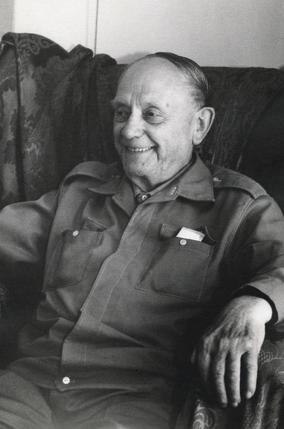Květoslav Vašíček
born 1902 in Kyjov (Gaya), lived in Kyjov, died in 1995 in Kyjov.
The work of Květoslav Vašíček does not have much in common with the development of modern art, even though most of his work could stand up to Duchamp’s famous “Bottle Dryer.” Modernism meant a radical deviation from the story, and narrativity was considered a mortal sin. Art was supposed to covertly embody pure ideas whose complex exposure and illumination has occupied a league of art experts. In this light, Duchamp’s collection of objects exceeds entirely any ideological framework and becomes a historical image, which, to be sure, says something about a specific time and place, but also carries within itself timeless aspects of the myth of human ingenuity and indefatigability.
Květoslav Vašíček was not motivated by artistic ambition. His incentives were purely existential. When the Communists nationalized his ironworks in 1948 in his native Kyjov, he began working as a locksmith in a glassworks. He did not expect the new regime to last long and therefore secretly prepared at home to renew his trade. He collected and stored up a varied assortment of iron and kitchen wares, especially wooden and metal screws. As he found out later in the 1990s, he had a larger collection than in Paris hardware stores. To beat out any possible competition, he supplemented his storehouse with artifacts of his own design, as well. During the production these works, he hit upon various minor improvements.
The regime remained firmly in power, and his dream of resurrecting his business was growing more and more unrealizable. Květoslav’s inventions slowly began to lose their unambiguous practical purpose. His creative absorption and sudden inspiration pushed considerations of utility to the background. His son Pavel Vašíček recalls how, during one of his visits to his father, they were struggling to cut up a smoked pork knuckle. When he visited Květoslav again two weeks later, he marveled at the brand-new “pork knuckle saw,” which his father had fashioned in the interim. Of course, it was such a specialized instrument that its practical uses could be counted on the fingers of one hand. On the other hand, his “nighttime chronometer” could be used nightly. It was a wooden box containing a light bulb into which would place his wristwatch at night. This allowed him to view the time in the dark without waking his wife.
At his peak, Květoš suppressed entirely the businessman within him and offered his inventions to his neighbors free of charge. His “grating apparatus” met with great success, whereas his “entire cauliflower head cooking apparatus,” despite Květoslav’s valiant efforts, did not achieve the popularity he had envisioned. Over time, most of his metal goods and many of his early artifacts succumbed to corrosion and had to be discarded. His sons Zdeněk and Pavel were arrested and jailed as political prisoners; their mother fell ill; and Květoš’s health abandoned him as well. As his sight gradually failed, he created lamps of various sizes, whose electrical connections would send chills up one’s spine today. Their house, however, did not burn to the ground. Three years before Kvetoslav’s 90th birthday, the regime fell. At this point he realized that his kitchen aids could hardly compete with the influx of Western goods, and he decided to concentrate on metal “potable water carriers.” Here his late work concludes.
The mind boggles at the number of gadgets that bear witness to the existence of an enigmatic character who, for almost half a century, devoted his work and energy to supporting and caring for his family. We all certainly have our own experiences with all sorts of do-it-yourselfers. Every now and then we see preposterous architecture among the colonies of cottages. We have all witnessed how monstrous ornaments can emerge when a handyman gets hold of some welding equipment. We have all have visited homes upon which the owner’s own creative ingenuity was stamped like an elephant’s foot. Do-it-yourself artifacts from the era of totalitarianism bear witness to the way one treated the only freedom that remained. By comparison, the work of Květoslav Vašíček, despite a certain eccentricity, comes across with a certain respectability. A freedom that is limited can be inspirational. What Květoslav’s artifacts to not possess is the usual ornamentality, sentimental coziness, and nostalgia. Each object attests , briefly and idiosyncratically, to a concrete problem of everyday life.
Whereas the modernist Duchamp tore objects from their utility in order to elevate them aesthetically, Květoslav Vašíček sought new paths to utility. In an era of astonishing yet highly impractical ideas, he invented instruments to better deal with the world, if only in the kitchen. Thereby, he brought back to life what the modernists had rendered lifeless.
Viktor Šlajchrt






